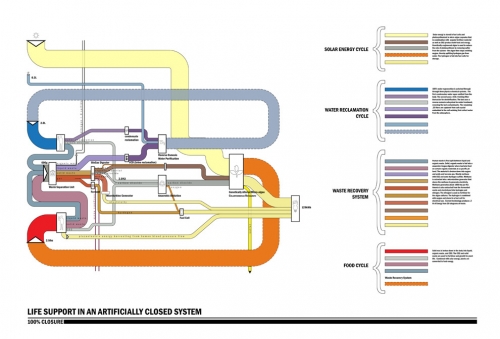I really had doubts, whether I should present the following Sankey diagram I found on John Locke’s Gracefulspoon blog [aesthetic photos there, have a look!]. Finally decided to feature it, because I want to show the whole spectrum of application fields for Sankey diagrams, and I am trying to put my focus more on the graphical aspects of the diagram rather than the explicit content of the diagrams.
The Sankey diagram featured in this post is for “life support in an artifically closed system” or in other words, a prison cell. John explains:
“a sustainable prison cell unit for future Beijing. Because of their high population density, prisons are actually prime contenders for tests of renewable energy methods, such as waste to energy, and water recycling features. … each prisoner generates energy for their own confinement, but also send excess energy back to a central grid, acting like capacitors.”
The Sankey diagram has four interconnected “cycles”, each with their individual units: the energy flows (kWh), the water cycle (Litres), the waste cycle (kg), and food flows (lbs). The four subsystems thus must be interpreted relative to each other and not with their absoulute values. The main input that “feeds” the system is solar energy, the main output is recovered energy. Apart from a freshwater input flow and some comparatively small waste output flows (branching out vertically), the system seems fully closed. It is of course an idealistic assumption that prisoners can be fed solely on genetically modified micro-algae…
If you look at the Locke’s ‘Global Panopticon’ study project “conceived more as a sci-fi narrative”, let’s just hope that such ideas never turn reality.

1 Comment
Ha! Nice find, dig the graphics.
Comments are closed.